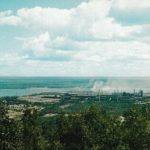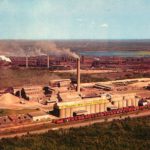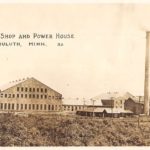United States Steel Duluth Works
It’s amusing to me that the soundtrack to this slideshow is by Dokken. You might think that’s a poor choice, but I remember 20 years ago the only Duluth kids into Dokken were from Morgan Park, so it makes sense.
Also, tragically, the one sentence of text in the video contains multiple errors, but oh well.
Some historical background:
United States Steel Duluth Works was the largest steel mill north of Chicago, employing nearly 3,000 people at its peak in the early 1960s. It was the lifeblood of western Duluth’s economy for 60 years.
The mill was first proposed by U.S. Steel in 1907. Plans for the plant were made public in the spring of 1910, when they were filed at the office of S.M. Kielly, city building inspector. The mill cost $25 million to build.
U.S. Steel also built the Morgan Park neighborhood as a company town for its workers to live. Both construction projects began in 1913.
Production at the mill began in 1915. U.S. Steel worked with area mining interests to produce rich grade iron ore. The mill steel helped build ships in Duluth shipyards that were used in two world wars.
Following World War II, the demand for iron ore began to dwindle, as did the amount of rich deposits available. The plant began to cut back, but still produced one-million tons of steel per year during the 1950s and 60s.
Rumors of the plant closing began in the 1970s. Materials needed to be shipped in, and shipping costs had gone up due to a weak regional economy. The company was also being squeezed by foreign competition.
In 1971, U.S. Steel announced it would begin phasing out the Duluth Mill operations. Members of the community formed a business/labor partnership and attempted to persuade the Minnesota Legislature to give U.S. Steel an incentive package by freezing real estate taxes for up to 13 years if the company would modernize its facility to employ a new process of mining taconite pellets. The bill failed to pass the Senate, on a 33-33 vote.
The blast furnace closed first. Two years later, cold-side production units were stopped. In 1975, the cement plant closed, ending it all.
Most of the buildings were torn down in the 1990s. The site is still contaminated and closed to the public, but it’s not all that dangerous there and access is easy. People wander in all the time. As far as Superfund sites go, it’s actually kind of lovely.
Recommended Links:
Leave a Comment
Only registered members can post a comment , Login / Register Here














8 Comments
markryan
about 14 years agoJPersch
about 14 years agoGerman Chris
about 14 years agoMike
about 14 years agoJoel S
about 14 years agoThe Big E
about 14 years agoDelly
about 14 years agoDonM
about 13 years ago